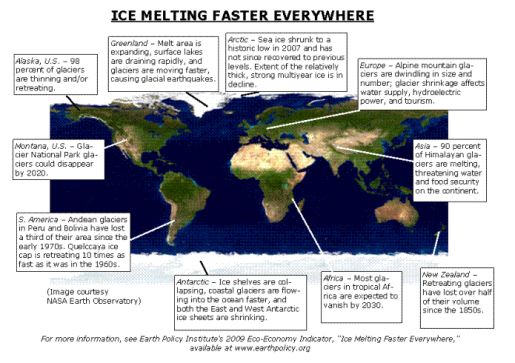Ice Melting Faster Everywhere
From the Arctic sea ice to the Antarctic interior and the mountainous peaks of Peru, Alaska, and Tibet, ice is melting at an alarming rate. The accelerating loss of ice sheets, sea ice, and glaciers is one of the most powerful and striking indicators of a warming climate. The most notable ice loss in recent years has been the shrinking of sea ice in the Arctic Ocean. From the beginning of the satellite record in 1979 through 1996, ice area decreased at a steady rate of 3 percent per decade in response to rising temperature. In the following decade, ice area decreased by 11 percent, reaching a dramatic minimum in 2007. In September of that year, sea ice occupied only 3.6 million square kilometers, an area 27 percent smaller than the previous record low (in 2005) and 38 percent smaller than the 1979–2007 average. Summer sea ice coverage has increased slightly in the last two years, but it is still far below the long-term average. (See figure.)  (See larger image of map.) Declines in ice thickness and volume are just as dramatic. The combination of these trends has led to a decrease in the amount of ice that persists in the Arctic through multiple seasons. Multiyear ice is more stable and less susceptible to break-up than the thin, short-lived seasonal ice that forms each winter. Between 1987 and 2007, the amount of ice at least five years old has plummeted from 57 to just 7 percent. (See figure.) Drastic changes in sea ice cover have led scientists from the University of Washington and the National Oceanic and Atmospheric Administration to predict that the summer of ... could see the first ice-free Arctic in a million years. http://www.earthpolicy.org/index.php?/indicators/C50
(See larger image of map.) Declines in ice thickness and volume are just as dramatic. The combination of these trends has led to a decrease in the amount of ice that persists in the Arctic through multiple seasons. Multiyear ice is more stable and less susceptible to break-up than the thin, short-lived seasonal ice that forms each winter. Between 1987 and 2007, the amount of ice at least five years old has plummeted from 57 to just 7 percent. (See figure.) Drastic changes in sea ice cover have led scientists from the University of Washington and the National Oceanic and Atmospheric Administration to predict that the summer of ... could see the first ice-free Arctic in a million years. http://www.earthpolicy.org/index.php?/indicators/C50
